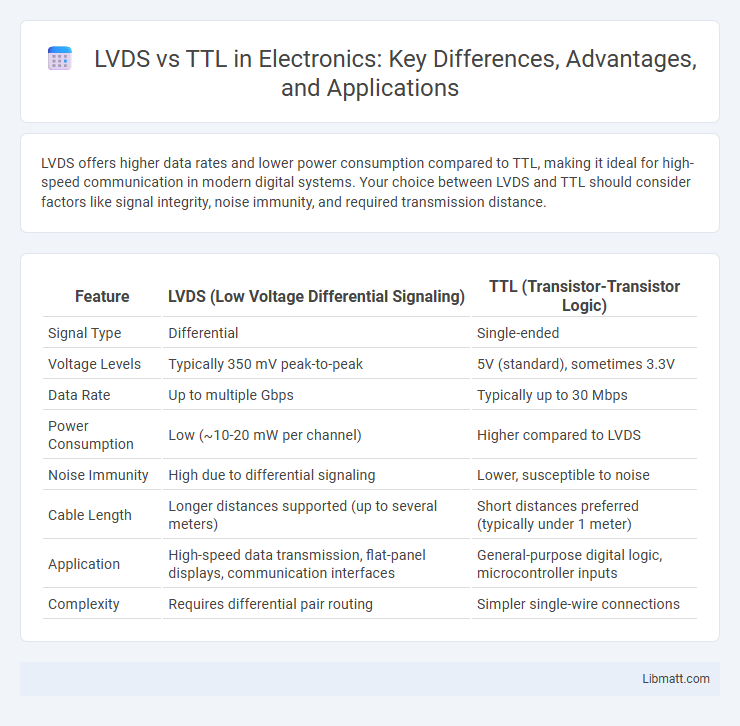LVDS offers higher data rates and lower power consumption compared to TTL, making it ideal for high-speed communication in modern digital systems. Your choice between LVDS and TTL should consider factors like signal integrity, noise immunity, and required transmission distance.
Table of Comparison
| Feature | LVDS (Low Voltage Differential Signaling) | TTL (Transistor-Transistor Logic) |
|---|---|---|
| Signal Type | Differential | Single-ended |
| Voltage Levels | Typically 350 mV peak-to-peak | 5V (standard), sometimes 3.3V |
| Data Rate | Up to multiple Gbps | Typically up to 30 Mbps |
| Power Consumption | Low (~10-20 mW per channel) | Higher compared to LVDS |
| Noise Immunity | High due to differential signaling | Lower, susceptible to noise |
| Cable Length | Longer distances supported (up to several meters) | Short distances preferred (typically under 1 meter) |
| Application | High-speed data transmission, flat-panel displays, communication interfaces | General-purpose digital logic, microcontroller inputs |
| Complexity | Requires differential pair routing | Simpler single-wire connections |
Introduction to LVDS and TTL
LVDS (Low-Voltage Differential Signaling) transmits data using differential signals with low voltage swings, resulting in high-speed communication and reduced electromagnetic interference. TTL (Transistor-Transistor Logic) operates with single-ended signals at standard voltage levels, commonly used in digital circuits but limited in speed and noise immunity. Understanding these signaling methods helps optimize Your system design for speed, power efficiency, and signal integrity.
Key Differences Between LVDS and TTL
LVDS (Low-Voltage Differential Signaling) transmits data using differential pairs, ensuring lower power consumption and higher noise immunity compared to TTL (Transistor-Transistor Logic), which uses single-ended signals. LVDS supports higher data rates and longer cable distances, making it ideal for high-speed communication, while TTL is typically limited to lower frequencies and shorter distances in digital circuits. Understanding these key differences helps you select the right signaling standard based on your requirements for speed, power efficiency, and signal integrity.
How LVDS Works
LVDS (Low Voltage Differential Signaling) operates by transmitting data using two complementary voltage signals over a twisted pair cable, minimizing electromagnetic interference and crosstalk. The differential voltage swing, typically around 350mV, allows for high-speed data transmission with low power consumption and enhanced noise immunity compared to TTL (Transistor-Transistor Logic) levels, which use single-ended signaling with voltage swings up to 5V. LVDS receivers detect the difference between the paired signals, enabling reliable communication over longer distances and higher frequencies.
How TTL Works
TTL (Transistor-Transistor Logic) operates by using bipolar junction transistors (BJTs) to switch between high and low voltage levels, typically 0V for logic low and 5V for logic high. The input signals control the transistors to rapidly switch states, enabling fast digital signal processing with standard voltage thresholds. TTL circuits are known for their ease of interfacing and compatibility with many digital systems but exhibit higher power consumption and limited noise immunity compared to differential signaling standards like LVDS.
Signal Integrity and Noise Immunity
LVDS (Low-Voltage Differential Signaling) offers superior signal integrity by utilizing differential pairs that reduce electromagnetic interference and crosstalk, maintaining high-speed data transmission over longer distances compared to TTL (Transistor-Transistor Logic). TTL signals, being single-ended and operating at higher voltage levels, are more susceptible to noise and signal degradation, resulting in limited noise immunity and shorter transmission ranges. LVDS's low voltage swing and differential signaling significantly enhance noise immunity, making it ideal for environments with high electromagnetic interference.
Power Consumption Comparison
LVDS (Low-Voltage Differential Signaling) consumes significantly less power than TTL (Transistor-Transistor Logic) due to its low voltage swing, typically around 350 mV, compared to TTL's 5 V. LVDS operates with differential signaling, reducing current draw and electromagnetic interference, which improves energy efficiency in high-speed data transmission. TTL's single-ended signaling requires higher voltage and current, resulting in greater power consumption and heat dissipation, making LVDS a preferred choice for power-sensitive applications.
Data Transmission Speed
LVDS (Low-Voltage Differential Signaling) supports high data transmission speeds typically up to several Gbps, making it ideal for high-bandwidth applications like video and high-speed communication interfaces. TTL (Transistor-Transistor Logic) operates at much lower frequencies, generally suitable for speeds below 100 Mbps, which limits its use in high-speed data transfer scenarios. LVDS's differential signaling reduces noise and allows faster data rates compared to the single-ended TTL signaling method.
Application Areas of LVDS vs TTL
LVDS (Low-Voltage Differential Signaling) is widely used in high-speed data communication applications such as video displays, telecommunications, and computer interfaces where minimal noise and signal integrity are crucial. TTL (Transistor-Transistor Logic) finds its application primarily in simpler, low-frequency digital circuits like microcontroller interfacing, basic logic control, and legacy digital systems. Your choice between LVDS and TTL depends on the speed, distance, and noise immunity requirements of your application area.
Design Considerations
LVDS offers lower power consumption and better noise immunity compared to TTL, making it ideal for high-speed data transmission in noisy environments. TTL signals use single-ended voltage levels, which can result in higher electromagnetic interference and limited cable length, impacting overall system reliability. Your design should weigh LVDS's differential signaling advantages against TTL's simpler implementation depending on speed, distance, and power requirements.
Choosing Between LVDS and TTL
Choosing between LVDS and TTL depends on your specific application requirements such as data transmission distance, speed, and noise immunity. LVDS (Low Voltage Differential Signaling) offers higher data rates, better noise immunity, and lower power consumption, making it suitable for high-speed, long-distance communication. TTL (Transistor-Transistor Logic) is ideal for short-distance, low-speed applications with simpler circuit designs and lower cost.
LVDS vs TTL Infographic

 libmatt.com
libmatt.com